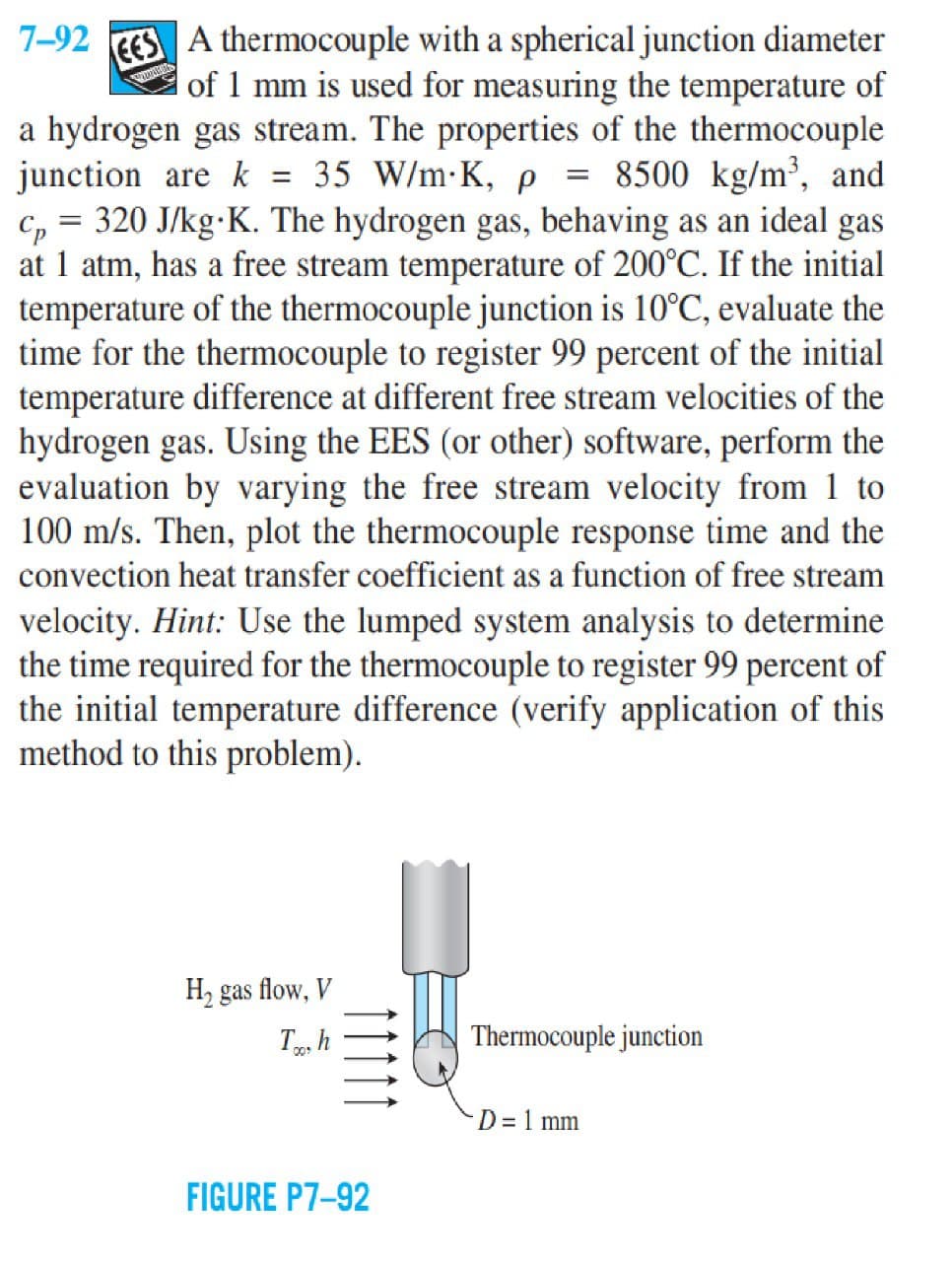EES |of 1 mm is used for measuring the temperature of a hydrogen gas stream. The properties of the thermocouple unction are k = 35 W/m·K, p = 320 J/kg-K. The hydrogen gas, behaving as an ideal gas at 1 atm, has a free stream temperature of 200°C. If the initial emperature of the thermocouple junction is 10°C, evaluate the ime for the thermocouple to register 99 percent of the initial emperature difference at different free stream velocities of the nydrogen gas. Using the EES (or other) software, perform the evaluation by varying the free stream velocity from 1 to 100 m/s. Then, plot the thermocouple response time and the 8500 kg/m?, and %3D convection heat transfer coefficient as a function of free stream velocity. Hint: Use the lumped system analysis to determine he time required for the thermocouple to register 99 percent of he initial temperature difference (verify application of this method to this problem).
EES |of 1 mm is used for measuring the temperature of a hydrogen gas stream. The properties of the thermocouple unction are k = 35 W/m·K, p = 320 J/kg-K. The hydrogen gas, behaving as an ideal gas at 1 atm, has a free stream temperature of 200°C. If the initial emperature of the thermocouple junction is 10°C, evaluate the ime for the thermocouple to register 99 percent of the initial emperature difference at different free stream velocities of the nydrogen gas. Using the EES (or other) software, perform the evaluation by varying the free stream velocity from 1 to 100 m/s. Then, plot the thermocouple response time and the 8500 kg/m?, and %3D convection heat transfer coefficient as a function of free stream velocity. Hint: Use the lumped system analysis to determine he time required for the thermocouple to register 99 percent of he initial temperature difference (verify application of this method to this problem).
Principles of Heat Transfer (Activate Learning with these NEW titles from Engineering!)
8th Edition
ISBN:9781305387102
Author:Kreith, Frank; Manglik, Raj M.
Publisher:Kreith, Frank; Manglik, Raj M.
Chapter5: Analysis Of Convection Heat Transfer
Section: Chapter Questions
Problem 5.22P
Related questions
Question

Transcribed Image Text:7-92 FES A thermocouple with a spherical junction diameter
of 1 mm is used for measuring the temperature of
a hydrogen gas stream. The properties of the thermocouple
junction are k = 35 W/m-K, p = 8500 kg/m³, and
c, = 320 J/kg-K. The hydrogen gas, behaving as an ideal gas
Cp
at 1 atm, has a free stream temperature of 200°C. If the initial
temperature of the thermocouple junction is 10°C, evaluate the
time for the thermocouple to register 99 percent of the initial
temperature difference at different free stream velocities of the
hydrogen gas. Using the EES (or other) software, perform the
evaluation by varying the free stream velocity from 1 to
100 m/s. Then, plot the thermocouple response time and the
convection heat transfer coefficient as a function of free stream
velocity. Hint: Use the lumped system analysis to determine
the time required for the thermocouple to register 99 percent of
the initial temperature difference (verify application of this
method to this problem).
H2 gas flow, V
T, h
Thermocouple junction
D=1 mm
FIGURE P7-92
1111
Expert Solution
This question has been solved!
Explore an expertly crafted, step-by-step solution for a thorough understanding of key concepts.
This is a popular solution!
Trending now
This is a popular solution!
Step by step
Solved in 3 steps

Knowledge Booster
Learn more about
Need a deep-dive on the concept behind this application? Look no further. Learn more about this topic, mechanical-engineering and related others by exploring similar questions and additional content below.Recommended textbooks for you

Principles of Heat Transfer (Activate Learning wi…
Mechanical Engineering
ISBN:
9781305387102
Author:
Kreith, Frank; Manglik, Raj M.
Publisher:
Cengage Learning

Principles of Heat Transfer (Activate Learning wi…
Mechanical Engineering
ISBN:
9781305387102
Author:
Kreith, Frank; Manglik, Raj M.
Publisher:
Cengage Learning